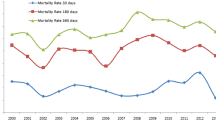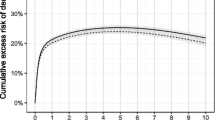Abstract
Background and aims: Prediction of factors associated with survival following hip fracture is important. We studied crude and adjusted survival rates in elderly hip fracture patients with and without atrial fibrillation (AF) to assess possible risk of death associated with AF. Methods: A historical prospective cohort study, comprising 1114 consecutive patients with hip fractures. Subjects were divided into three groups: patients with sinus rhythm (SR), paroxysmal atrial fibrillation (PAF) or chronic atrial fibrillation (CAF). The main outcome measures were crude and adjusted survival rates at 30, 90 and 365 days, and end of follow-up. Results: AF patients differed from SR patients by gender (p=0.0018), age (p=0.008), heart failure (p<0.001), ischemic heart disease (p<0.001) and history of a stroke (p<0.001). The lowest death rates were observed among SR and PAF patients, whereas CAF patients had the highest rates at each follow-up time point. CAF (but not PAF or SR) patients were at a significantly higher risk of death at both 365 days and at the end of the study (HR 1.786, CI 1.011- 3.155 and HR 1.835, CI 1.302–2.585, respectively). Older age (HR 1.301, CI 1.135–1.491 and HR 1.321, CI 1.321–1.415) and male gender (HR 1.879, CI 1.271–2.779 and HR 1.545, CI 1.251–1.909) also predicted higher risk of death at both 365 days and at the end of the study. Conclusions: Atrial fibrillation cannot be considered to adversely affect short-term survival of hip fracture patients. After 365 day, CAF was associated with a significantly higher risk of death.
Similar content being viewed by others
References
Go AS, Hylek EM, Phillips KA et al. Prevalence of diagnosed atrial fibrillation in adults: national implications for rhythm management and stroke prevention: the anticoagulation and risk factors in atrial fibrillation (ATRIA) study. JAMA 2001; 285: 2370–5.
Benjamin EJ, Wolf PA, D’Agostino RP, Silbershatz H, Kannel WB, Levy D. Impact of atrial fibrillation on the risk of death: the Framingham Heart Study. Circulation 1998; 98: 946–52.
Goldman L, Caldera D, Nussbaum SR et al. Multifactorial index of cardiac risk in noncardiac surgical procedures. N Eng J Med 1997; 297: 845–50.
Pioli G, Barone A, Giusti A et al. Predictors of mortality after hip fracture: results from 1-year follow-up. Aging Clin Exp Res 2006; 18: 381–7.
Robbins JA, Biggs ML, Cauley J. Adjusted mortality after hip fracture: from the Cardiovascular Health Study. J Am Geriatr Soc 2006; 54: 1885–91.
Brauer CA, Coca-Perraillon M, Cutler DM, Rosen AB. Incidence and mortality of hip fractures in the United States. JAMA 2009; 302: 1573–9.
Eagle KA, Black OR, Cook EF, Goldman L. Evaluation of prognostic classifications for patients with syncope. Am J Med 1985; 79: 455–60.
Martin TP, Hanusa BH, Kapoor WN. Risk stratification of patients with syncope. Ann Emer Med 1997; 29: 459–66.
Rejnmark L, Vestergaard P, Mosekilde L. Fracture risk in patients treated with amiodarone or digoxin for cardiac arrhythmias. A nation- wide case-control study. Osteoporosis Int 2007; 18: 409–17.
De Luise C, Brimacombe M, Pedersen L, Sørensen HT. Comorbidity and mortality following hip fracture: a populationbased cohort study. Aging Clin Exp Res 2008; 20: 412–8.
Roche JJ, Wenn RT, Sahota O, Moran CG. Effect of comorbidities and postoperative complications on mortality after hip fracture in elderly people: prospective observational cohort study. BMJ 2005; 331: 1374–9.
Kannegaard PN, Van der Mark Susanne, Eiken P, Abrahamsen B. Excess mortality in men compared with women following a hip fracture. National Analysis of Comedications, Comorbidity and Survival. Age Ageing 2010; 39: 201–9.
Vestergaard P, Rejnmark L, Mosekilde L. Increased mortality in patients with a hip fracture-effect of pre-morbid conditions and post-fracture complications. Osteoporos Int 2007; 18: 1583–93.
Petersen MB, Jørgensen HL, Hansen K, Duus BR. Factors affecting postoperative mortality of patients with displaced femoral neck fracture. Injury 2006; 37: 705–11.
Paksima N, Koval KJ, Aharanoff G et al. Predictors of mortality after hip fracture: a 10-year prospective study. Bull NYU Hosp Jt Dis 2008; 66: 111–7.
Adunsky A, Arad M, Levi R, Blankstein A, Zeilig G, Mizrachi E. Five-year experience with the ’Sheba’ model of comprehensive orthogeriatric care for elderly fracture patients. Disabil Rehabil 2005; 27: 1123–7.
Adunsky A, Levi R, Cecic A, Arad M, Noy S, Barell V. The “Sheba” model of comprehensive orthogeriatric care for elderly hip fracture patients: a preliminary report. Isr Med Assoc J 2002; 4: 259–61.
Fuster V, Rydén LE, Cannom DS et al. ACC/AHA/ESC 2006 guidelines for the management of patients with atrial fibrillation: a report of the American College of Cardiology/American Heart Association Task Force on practice guidelines and the European Society of Cardiology Committee for Practice Guidelines, developed in collaboration with the European Heart Rhythm Association and the Heart Rhythm Society. Europace 2006; 8: 651–45.
Friberg L, Hammar N, Pettersson H, Rosenqvist M. Increased mortality in paroxysmal atrial fibrillation: report from the Stockholm Cohort-Study of Atrial Fibrillation (SCAF). Eur Heart J 2007; 28: 2346–53.
Keating RJ, Gersh BJ, Hodge DO, et al. Effect of atrial fibrillation pattern on survival in a community-based cohort. Am J Cardiol 2005; 96: 1420–4.
Corley SD, Epstein AE, DiMarco JP, et al. Relationships between sinus rhythm, treatment, and survival in the Atrial Fibrillation Follow-Up Investigation of Rhythm Management (AFFIRM) Study. Circulation 2004; 109: 1509–13.
Wyse DG, Love JC, Yao Q et al. Atrial fibrillation: a risk factor for increased mortality— an AVID registry analysis. J Interv Card Electrophysiol 2001; 5: 267–73.
Jacobs DR jr, Kroenke C, Crow R et al. PREDICT: a simple risk score for clinical severity and long-term prognosis after hospitalization for acute myocardial infarction or unstable angina: the Minnesota heart survey. Circulation 1999; 100: 599–607.
Forsén L, Sogaard AJ, Meyer HE, Meyer HEe, Edna T, Kopjar B. Survival after hip fracture: short- and long-term excess mortality according to age and gender. Osteoporos Int 1999; 10: 73–8.
Adunsky A, Lerner-Geva L, Blumstein T, Boyko V, Mizrahi EH, Arad M. Improved survival of hip fracture patients treated within a comprehensive geriatric hip fracture unit, compared with standard of care treatment. J Am Med Dir Assoc 2011; 12: 439–44.
Dubey A, Aharonoff GB, Zuckerman JD, Koval KG. The effects of diabetes on outcome after hip fracture. Bull Hosp Jt Dis 2000; 59: 94–8.
Lloyd-Jones DM, Wang TJ, Leip EP et al. Lifetime risk for development of atrial fibrillation: the Framingham Heart Study. Circulation 2004; 110: 1042–6.
Heeringa J, Van der Kuip DA, Hofman A et al. Prevalence, incidence and lifetime risk of atrial fibrillation: the Rotterdam Study. Eur Heart J 2006; 27: 949–53.
Sanoski CA. Prevalence, pathogenesis, and impact of atrial fibrillation. Am J Health Syst Pharm 2010; 67(9 Suppl 5): S11–6.
Heeringa J. Atrial fibrillation: is the prevalence rising? Europace 2010; 12: 451–2.
Gage BF, Birman-Deych E, Radford MJ, Nilasena DS, Binder EF. Risk of osteoporotic fracture in elderly patients taking warfarin. Arch Intern Med 2006; 166: 241–6.
Saa TP, Leufkens HGM, Cooper C. Utility of medical and drug history in fracture risk prediction among men and women. Bone 2002; 31: 508–14.
Ottenbacher KJ, Smith PM, Illig SB, Linn RT, Ostir GV, Granger CV. Trends in length of stay, living setting, functional outcome, and mortality following medical rehabilitation. JAMA 2004; 292: 1687–95.
Stineman MG. Measuring casemix, severity, and complexity in geriatric patients undergoing rehabilitation. Med Care 1997; 35 (Suppl 6): JS90–105.
Rønning OM, Stavem K. Predictors of mortality following acute stroke: A cohort study with 12 years of follow-up. J Stroke Cerebrovasc Dis 2010 [Epub ahead of print] PMID 21075646.
Kaarisalo MM, Immonen-Raiha P, Marttila RJ et al. Atrial fibrillation and stroke. Mortality and causes of death after the first acute ischemic stroke. Stroke 1997; 28: 311–5.
Lieberman D, Friger M, Fried V et al. Characterization of elderly patients in rehabilitation: stroke versus hip fracture. Disabil Rehabil 1999; 21: 542–7.
Carinci F, Roti L, Francesconi P et al. The impact of different rehabilitation strategies after major events in the elderly: the case of stroke and hip fracture in the Tuscany region. BMC Health Serv Res 2007; 27: 95.
Cauly JA, Thompson DE, Ensrud KC, Scott JC, Black D. Risk of mortality following clinical fractures. Osteoporos Int 2000; 11: 556–61.
Johnell O, Kanis JA. An estimate of the worldwide prevalence, mortality and disability associated with hip fracture. Osteoporos Int 2004; 15: 897–902.
Author information
Authors and Affiliations
Rights and permissions
About this article
Cite this article
Arad, M., Koren-Morag, N., Fleissig, Y. et al. Increased 1-year mortality rates among elderly hip fracture patients with atrial fibrillation. Aging Clin Exp Res 24, 233–238 (2012). https://doi.org/10.1007/BF03325251
Received:
Accepted:
Published:
Issue Date:
DOI: https://doi.org/10.1007/BF03325251




